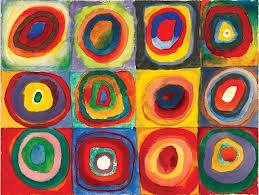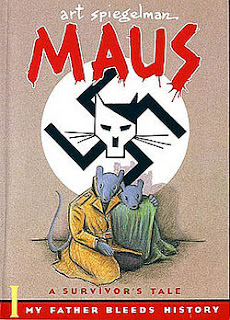Part I: Bibliographic information
Type: Graphic novel
Title: Maus: A Survivor’s Tale
Writer: Art Spiegelman
Copyright Date: 1986
Publisher: Pantheon Books
ISBN: 0394747233
Genre/subgenre: Graphic/comic
Interest Age: 13+
Reading Level: Upper Grades (UG 9-12)
Pages: 159
Awards: Pulitzer Prize, 1992
Part I: Reader’s Annotation, Plot Summary, Critical Evaluation
Reader’s Annotation -- A recounting of the experiences of a Polish man who survives the Holocaust and late in life shares his story to his son, Art, a writer and comic artist who hopes to make a graphic novel from the material.
Plot Summary -- Maus (1986) follows Art Spiegelman’s parents -- who were both Holocaust survivors -- through the time leading up the German invasion of Poland. The story begins in 1938 with Art’s father Vladek as a young businessman in his native Poland. He works hard to build a life for himself and eventually marries into a good family that have a hosiery factory. However, the threat of German invasion is mounting in Poland as is that anti-Semitism throughout Europe. After their marriage and the birth of their first child -- a boy named Richieu who does not survive the war -- Anje has a nervous breakdown of sorts and they go to a sanitarium in Czechoslovakia. There they see the Nazi flag and towns being cleared of Jewish residents and their future becomes even more uncertain upon return home.
Eventually Vladek is drafted as the invasion of Germany looks inevitable. The Poles are poorly trained and not prepared for the German forces who quickly overrun the country. Vladek is taken to a prison camp after being captured and experiences the traumas of near starvation and desperate living conditions. A series of minor miracles occur that leads to his release and he makes his way back to his family. They are forced out of their home and forced to register as Jewish in mass events that lead to those without jobs essential to the war effort being sent away. Vladek finds work in a factory for a time. But the grandparents are sent away as things worsen and later it’s clear they perished in the German concentration camps. In desperation, Anja and Vladek decide to send their boy Richieu away to relative safety, a decision they later regret as he does not survive.
The remaining family attempt to elude the authorities as restrictions on Jews increases and they are forced into quarters where there is insufficient everything. Some take money from them for hiding places; however, Vladek’s brave attempts to protect his family begin to fall to pieces as his in-laws are taken away by vans soon to perish at Auschwitz. Desperate to simply survive long enough to get out of Poland or outlast the war, Anje and Vladek live with a women in a small home but they have to leave when her husband returns periodically. They wander seeking on unsafe streets seking shelter and live in a barn. Vladek learns to disguise himself as a non-Jewish Pole but it becomes increasingly difficult and finally they, too, are found out.
This entire story is retold year’s later to the author by his elderly father in a series of visits to older man’s home in Queens, N.Y. The then elderly Spiegelman is suffering from angina and has remarried unhappily after Art’s mother Anja committed suicide. Art, the son and author, does not feel close to his overbearing and critical father but he decides to make a comic out the untold story, which has a youngster his father would not discuss with him. The dynamic of of he second wife who feels his father is cruel to her and the father’s nearly obsessive habit of collecting bits and pieces of spare things to reuse and his strong sense of self-reliance are an important aspect of the plot as well.
The retold story ends as Art’s parents are headed to the concentration camps and Maus II (1991) picks up at that point.
Critical Evaluation -- Spiegelman wrote Maus in the 1970s, and it was published in installments during the early 1980s in the comic anthology known as Raw. The story of the Holocaust is one that is so well-known that you might wonder what makes his rendition particularly unique. First, it’s a first-hand account of a survivor who tells the tale of the Spiegelman family -- most of whom perish in the concentration camps. Second, it provides details of the day-to-day experiences that European Jews encountered during this period and that often go unmentioned in typical historical accounts. This provides a gripping and dramatic read that’s hard to believe and hard to put out of your thoughts subsequently.
The story is told by Vladek Spiegelman, the author/illustrator’s father, as he recounts the unbelievable tale of surviving impossible odds in wartime Poland to his son many years later. Art Spiegelman writes into the story the details of getting the story out of his father through a series of visits to his home during his father’s elder years and after he has remarried unhappily. The father and son are not terrible close, and the father is cantankerous and bothered by a bad heart during the whole retelling. He had once been a successful young Polish businessman with hopes for a bright future. But fate had in store a different path that took him from marriage into a well-off family of a Hosier merchants in 1939 to the camp at Auschwitz in 1944. It’s truly a tale so horrific that’s hard to believe that it happened during modern times.
The literary device of using cat characters for the Nazis and mice for the Jews is particularly effective in conveying the feeling of the times. The Poles, many of whom collaborated with the Germans to push Jews out of Poland, are depicted as pigs. This is a classic in the comic world and one that has proved timeless. The ending Maus leaves the reader poised for the second volume of this work.
Part III: Author Info
Art Spiegelman is a well-known writer and graphic artist whose work Maus won him recognition as one of the most respected comic artists of all time. He was born in 1948 to a Jewish Polish couple who survived the Holocaust and later relocated the family to the United States. Spiegelman became active in the alternative comic scene in the 1970s and was co-publisher of the experimental comic RAW. His work Maus was originally published in RAW prior to becoming a graphic novel release of hugely successful proportions and a work that would later be honored with a Pulitzer prize, the only comic to win this distinction.
Spiegelman has taught at the School of Visual Arts in New York and mentored younger cartoonists, according to wikipedia. He married a fellow comic artist Francoise Mouly with whom he has collaborated for many years in the graphics arts world. They have two children and lived near the World Trade Center before the attacks -- later his comic motifs as published serially in The New Yorker magazine would focus on the surrounding events. He left the magazine for political reasons in 2004 but remains active in the publishing world on various projects, including several children’s books.
Part IV: Curriculum Ties, Diversity, Booktalk Ideas, Challenge Issues
Curriculum Ties, if any -- This work is an obvious pick for any study of U.S. or world history that visits the topic of the Holocaust.
Diversity of Cultures -- This novel explores mid-20th century Polish culture, the European Jewish experience and touches on the German mindset of the time.
Booktalking Ideas -- The obvious choice is to discuss the Holocaust. I think a more original discussion would evolve in addressing the importance of the father-son relationship in this work. Art says in the beginning that he and his father are not that close. Why is that? Has some of the trauma that his father experienced passed along to the son? What created gaps between generations?
Challenge Issues -- This work was published as an adult graphic novel. The content is sufficiently heavy that younger readers could be confused if some historical background was not presented prior to reading the work. It may appear to be something of a fantastical story rather than the reality that it portrays so effectively that it’s almost beyond belief.
Part V: Reasons chosen
When Spiegelman's Maus (1987) reached the mass market as an independently published graphic novel, the comic world was not quite ready for the result. Originally, this world was published serially in the relatively obscure comic anthology known as RAW (1980). This small-press graphic magazine catered to the art-house comic reader and was not easy to obtain. Maus on the other hand broke through the barrier of the comic genre and is now published in 30 languages and used to teach Holocaust history in Germany among other places. This is quite literally one of the most important works about the Holocaust. First, it has reached millions of readers who might not otherwise pick up a work about this subject. Second, it is an engaging, highly personal story that makes the abstraction that is the Holocaust come to life for the layperson who has little understanding of the day-to-day realities of ordinary European Jews suffered. It is a tale that is simply unforgettable, and Spiegelman's artistic treatment of the subject matter is quite brilliant in its postmodern simplicity. I cannot say enough about this works importance in the evolution of the graphic novel and its present importance as a legitimate sub-genre within juvenile literature. It sets a standard of excellence that perhaps will never be surpassed.
Part VI: Citations
Art Spiegelman. (n.d.). Wikipedia.com [webpage]. Retrieved from http://en.wikipedia.org/wiki/Art_Spiegelman.
Maus. (n.d.). Wikipedia.com [webpage]. Retrieved from http://en.wikipedia.org/wiki/Maus.


No comments:
Post a Comment